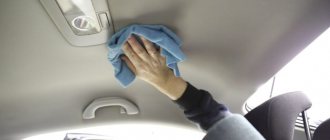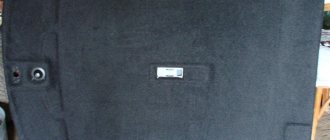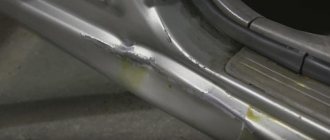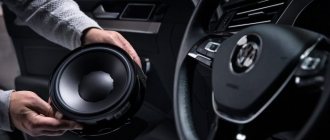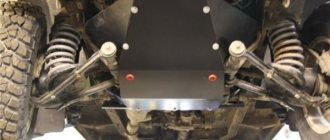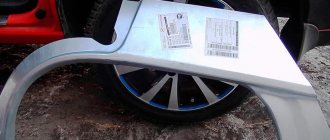The vehicle coating provides not only a presentable appearance, but also additional protection. But, like other materials, the paint surface has a limited service life. Under the influence of loads, minor damage gradually appears on it. Therefore, it will be useful for car owners to know how to paint over a scratch on a damaged car with their own hands.
Different ways to remove grooves
Small cobwebs on a car's paintwork can be removed without touching up the defect, but using the polishing method. To do this, use abrasive or wax polishes. The first type of composition removes a very thin layer of varnish until the scratch disappears, so it cannot be used frequently so as not to remove the entire protective layer from the undamaged area. Wax polishes fill the cobwebs, but after two or three washes the procedure will have to be repeated again and again.
If the protection in the form of a varnish layer or enamel is damaged, then the grooves can be covered with a wax or gel pencil; in this case, touch-up is not required. Special products in tubes or in the form of pencils are also used in cases where it is necessary to mask scuffs of the paintwork.
There is an anti-scratch product on sale in the form of special brushes for removing coating defects, which can be used to cover fairly deep grooves. The composition contains fiberglass, so its use does not require preliminary priming.
Remember that this product can only be used once, as the paint dries very quickly after opening the tube.
If the depth of the groove reaches the ground or metal, then in order to remove it, a more complex repair of the damaged area is necessary - painting over the scratches on the car. To do this, prepare the following tools and materials:
- sandpaper P1500, P2000;
- polishing paste;
- a grinding machine or drill with a set of discs;
- putty;
- rubber or plastic spatulas;
- primer;
- auto enamel color of your car;
- protective varnish;
- surface degreasing composition;
- brush, spray gun or roller.
Let's figure out how to paint over a scratch on a car with your own hands using these tools. By following step-by-step instructions, you can remove defects in your car's paintwork yourself, saving significant money.
What are the dangers of damage to body paint?
LKP is the painting of a car with paint and varnish. The purpose of the paintwork is to protect the vehicle from untimely destruction of the metal and give the car an aesthetic appearance. Plastic parts, such as bumpers, can also be damaged by paintwork.
The paintwork consists of several layers:
- Primer. The primer consists of special substances that are resistant to external weather conditions and minor deformation. You can select acid primer (used before painting work, prevents oxidation of the metal surface), epoxy (anti-rust), acrylic (necessary for body repairs).
- Intermediate – body color. Car enamels can be acrylic (characterized by quick drying, resistance to mechanical damage and climatic disasters), metallic (thanks to metal powder, the body has an original shine), alkyd (cheap, but that’s where their advantages end - they are difficult to polish, it is almost impossible to achieve a mirror effect). Some types of paint require the addition of varnish. Bumpers and rims are painted with special paints.
- Covering. This layer is a varnish, designed to protect the paint from ultraviolet radiation and the negative influence of weather conditions. Acrylic varnish dries quickly, but when applying the technology must be fully observed. The composition of glypthal varnish includes a synthetic resin, which provides elasticity to the protective coating. Cellulose varnish is generally not used in auto repair. Polyurethane is resistant to acids, gasoline and brake fluid. Acrylic polyurethane varnish consists of two components that have their properties.
Interesting to know! Each manufacturer has developed its own scheme for treating the car body with protective agents that differ in their composition. And how durable the coating is will determine how long the car body will not corrode.
Therefore, every motorist must keep his vehicle completely clean and protect it from the appearance of cracks, especially large ones.
Local application products - fast, cheap and easy
Another way to restore a body is to use special automotive products aimed at masking and completely removing scratches. This group of products includes wax and gel correctors, as well as specific pencils. The color palette of the products presented is very wide, you can easily choose the pencil that perfectly matches the shade of your car.
The main advantages of using these tools include:
- Ease of work.
- High speed of the process.
- Low cost of goods.
The main disadvantage of correctors is that, as you can guess from the name, they do not so much restore scratches as simply mask them. The consequence of this is the need to periodically update the shaded layer. At first, the drying composition perfectly hides any damage to the car, but over time, the paint begins to crack and deteriorate, which leads to the reuse of pencils.
We recommend: DIY diesel engine turbine repair
The automotive goods market can please us with many other interesting products that allow us to paint any minor body defects in the shortest possible time. Degreasers, special wipes, car varnishes, masking polymers - all these products make it possible to get rid of minor damage, as well as additionally protect the car body, preventing the possibility of rust.
"Everest", wax pencil
"Everest", wax pencil
"Everest", wax pencil
Declared, Russia
Estimated price: 160 rub.
The “Magic Pencil” playfully restores shine and eliminates sponge stains. This is where the advantages end. The composition does not fill scratches, the plastic spatula included in the kit is inconvenient, its sharp, untreated edges can even damage the coating. The pencil melts in your hands and gets dirty. And the results of the treatment are short-lived. Like, he tinted the car and sold it.
Removing scratches on the body with a Fix it Pro pencil
If there is only superficial damage to the varnish coating, then there is an excellent way to remove such scratches that does not require specific skills and can be done by any amateur - this is a special pencil for removing scratches Fix it Pro.
After just a few uses, the Fix it Pro pencil will not leave any traces of scratches on the surface of the body. The main advantages of the Fix it Pro pencil are:
- Simplicity and ease of use;
- It matches any car color;
- Almost instantly removes small scratches and chips;
- Fix it Pro can be used multiple times;
- A very affordable price and an opportunity to save on a visit to a car service center.
However, in fairness, it is worth noting that small scratches can be easily removed not only with a pencil. According to “experienced” motorists, RENUMAX compositions cope more effectively with scratches and other minor damage to a car’s paintwork.
And given the low cost and ease of use, RENUMAX can confidently be called one of the most popular means for removing scratches on a car body without painting.
But still, miracles do not happen and you should remember that both the Fix it Pro pencil and the RENUMAX product will help restore ONLY the varnish coating of the car, and not the paint.
KratzerEntferner Set SONAX 305941
KratzerEntferner Set SONAX 305941
KratzerEntferner Set SONAX 305941
Declared manufacturer: SONAX, Germany
Estimated price: 880 rub.
The company is famous, but it has problems with translators: the Russian text does not correspond to the German. Wipes are difficult to secure to the initial treatment fixture. And most importantly, despite the complex two-component formula, the composition could not even cope with minor scratches and did not restore shine.
How to paint over a scratch on a car
No matter how careful the driver is, scratches will still appear on the car. Damage of this type is divided into several groups depending on a number of signs:
- minor scratches of the first level that damaged the paintwork;
- medium scratches of the second level, damaging the top layer and primer;
- deep scratches of the third level, damaging all layers of the coating, including metal.
Special tools are used to paint scratches on a car. But to understand what kind of device you will need to restore the surface, you need to determine the type of scratch.
There are also several types of damage repair methods:
- spot;
- polishing;
- using a brush;
- using a can of spray paint;
- with a full renovation.
In most cases, no labor-intensive effort is required to remove the scratch. To do this, it is not necessary to contact a service center - you can paint over the scratch on the damaged area yourself.
Spot painting
Spot painting is also known as retouching. This method involves several ways to restore the surface of a car, depending on the level of damage.
Most often, this type of painting is used to remove level 1 scratches that have damaged the paintwork. When performing spot painting, the locations of scratches are determined, after which painting is carried out. The task is completed independently using marker pencils.
If there are second-level scratches on the coating that have damaged the paintwork and primer, local agents are used. These include a polymer chalk pencil and a paint brush. It is recommended to apply the paint in several layers.
Paint a scratch only in clean and dry areas. You need to wait until the surface dries before applying the next coat of paint.
Polishing
If there are scratches, painting is not always necessary. In some cases, polishing is sufficient. This method is only suitable if it is necessary to remove shallow scratches. To determine their presence, you need to wet the surface and wait until it dries. After this, the scratches will appear on their own.
We recommend: Do-it-yourself car mirror repair
You can remove the scratch by polishing it yourself or at a car wash. It requires a special wax paste. The substance fills the scratch, causing it to disappear. But it should be borne in mind that polishing provides a temporary effect. Therefore, in order to maintain the paintwork in a new condition, it is necessary to periodically repeat this action.
When to seek professional help
If you have no experience in restoration work or lack time, it is recommended to contact professionals to help carry out all the work. It happens that the cracks were fixed on their own, but they were not satisfied with the result. In this case, you will have to contact specialists.
It turns out that if the paintwork is severely damaged, it is very difficult to eliminate the defect; it is easier to repaint the part completely. At any service station, employees will agree with this. Therefore, if you have no work experience or no confidence in your abilities, you should entrust the work of removing scratches to specialists.
The cost of restoring the car to its original appearance will depend on how damaged the car is and the level of the service station. If the station is located in Moscow or another large city, then the prices differ from the periphery. When assessing the cost, the make of the vehicle is taken into account. Repairing a minor scratch will cost 1,500 rubles, repairing moderate damage will cost 2,500 rubles, and a large scratch can cost 6,500 rubles. If painting is not required to remove the crack, the express method will be used. The entire work will take 2-2.5 hours. If painting is needed, everything will take 3 days.
Preparing the surface area for painting
Painting over scratches on a car begins with the process of preparing the damaged area of the paintwork, which can be reduced to the following sequence of actions.
- Sanding the damaged area. First you need to remove dirt and, if present, rust. For sanding, use a sander or sandpaper. Rub the area down to the metal or scratch depth level. The result should be a flat, smooth surface. Begin the initial sanding using P1500 sandpaper. Sand the intact paintwork around the working area with finer grit P2000 paper. Do the cleaning carefully and rationally, not forgetting that the larger the area you cover, the more you will need to paint.
- The prepared area on the car body must be degreased with white spirit, xylene or gasoline.
- Apply a layer of putty. You can use polyester putty along with a hardener. Mix the hardener and putty and apply the mixture to the work area. When working with the material, use the instructions for the specific composition. It is important to correctly observe the proportions of mixing the components, otherwise the putty may harden before being applied to the car body.
- After the putty has dried, sand it to a smooth surface.
- Your next step is to apply a primer. For local repair of car body paintwork, it is better to use the composition in aerosol packaging, which will give a good quality result and speed up the priming process. You can also use the compositions in jars, applying them with a brush.
- The dried primer layer must be sanded wet with fine-grained sandpaper.
At this point, the preparation of the car body is completed and the next step is directly painting over the scratches on the car.
DoctorWax DW8275
DoctorWax DW8275
DoctorWax DW8275
Declared manufacturer: USA
Estimated price: 240 rubles.
The polish copes well with abrasions and scratches up to medium. Suitable for manual and machine surface treatment. According to the manufacturer, for the best effect, you should first wash the car with shampoo, but only of the same brand. Even its specific type is indicated. We won’t find fault with this: in the end, the manufacturer knows best...
Restoring the paint layer - preparation and main steps
Experienced motorists know very well that any damage to the car body can be repaired. Especially when it comes to such minor problems as scratches. Even without minimal experience in handling such damage, anyone can paint over a scratch on a car with their own hands, without visiting service stations. This saves time and, more importantly, money, since the result will be the same in any case.
Before painting a car, it is necessary to obtain some theoretical knowledge, in particular about the layers of the body surface. So, the following is the order, starting from the top:
- A layer of varnish.
- The base layer is enamel.
- Primer.
- Phosphate.
- Sheet steel is the deepest, last layer of the car body.
Depending on the layer damaged by contact with foreign bodies, the technology of restoration and restoration may differ significantly. The simplest, for obvious reasons, are scratches that only damage the paintwork. In this case, the operation to remove the damage may take a couple of minutes.
If during a trip you accidentally hit the fence and made a deep enough chip that touched the steel, then you will need to put in much more effort. But, we repeat, any damage of this nature, regardless of its depth, can be corrected at home.
Corrective cosmetics for the “face” of a car
Scratches that stand out brightly on the polished paint of a car are an unpleasant thing. Even more unpleasant than the rather stupid word “anti-scratch”, which has already taken root in everyday vocabulary to designate means designed to mask these very scratches as much as possible and “preserve” damage. In our rating today we will look at the best anti-scratch products that the market offers us.
What is anti-scratch in essence? In fact, it is a kind of hybrid of abrasive and finishing polishing paste. The abrasive component evens out the damaged area, smoothing out differences in the scratch area, while the wax fills them, at the same time masking them - the anti-scratch is sometimes helped by the dye introduced into the composition, which is selected as close as possible to the color of the car's paint. That is, you will get the same thing with regular polishing with several compounds in turn - just “anti-scratch” will make it faster and easier (but not better!), and it is usually sold in a small package designed for a small amount of work.
Car paint color selection
In cases where local touch-up of a car's paintwork is done, an important point is the correct selection of paint. It is very difficult to choose a shade so that it exactly matches the color of your car. There are no questions if you know the number of the auto enamel that your car is painted with. You simply purchase the necessary consumables at a hardware store and get to work. Otherwise, to accurately select the required color for a car body, there are several methods for determining the desired shade.
- Almost every vehicle has a label on which the VIN code is indicated. It is located on the driver's door pillar, on the inside of the hood or trunk lid, in a special window on the windshield. The VIN code is also in the car's passport. Manufacturers of car paints use a common system of standard tints used in the production of vehicles, so the selection of shade according to the code will be accurate.
- Contact a car repair shop, providing the technician with information about the make of the car, its model, and year of manufacture.
- The most accurate method is computer selection, using appropriate programs that compare the codes of car enamels with the one on the sample, and also select the optimal consistency of the material, depth and saturation of the color.
- Using a fan of colors does not guarantee a 100% match with the color of your car, but it can also be used to select car paint.
After you have chosen the desired shade of paint, it is time to proceed directly to painting the car body. Before applying auto enamel, degrease the prepared area with a solvent. Painting scratches on a car takes place in 2 layers. To do this, use a brush, roller or spray gun. If you are new to this business, it will be difficult to avoid smudges. In this case, after the layer has dried, you need to sand the surface wet and paint it again.
The best protection for paintwork is varnishing. Therefore, after painting the damaged area, apply a layer of varnish. The protection will be restored qualitatively if each new layer is applied so that it overlaps the previous one with some margin, forming an even transition.
What scratches can be removed using auto chemicals?
Before choosing a removal method, it is important to understand the nature of the impact, the depth of damage, which extends in depth to the following layers of paint:
- Lacquer.
- Enamel.
- Ground.
- Phosphate.
- Metal.
Defects are clearly visible:
Damage to the first layer can be repaired with light polishing or a scratch masking pencil. The latter is also suitable for removing damage from the enamel coating. Mechanical defects and scratches also appear on plastic, including in the interior, but they are usually shallow and easier to get rid of than on LPK.
How to remove small and deep defects with your own hands
Small and shallow scratches can be removed using regular polish. Circular lines and stains visible on the surface of the metal indicate low-quality and improperly carried out polishing. Eliminating such defects is as easy as shelling pears - an abrasive polish does not harm the paintwork and allows you to obtain a perfectly smooth and even surface.
A low-abrasive polish can handle more serious defects. With its help, you can eliminate visually invisible scratches that are easily tactilely felt.
The car body after treatment with an abrasive polish looks more presentable, but it is easy for a beginner to overdo it with pressure or choose the density of the composition
In case of serious cuts and damage, use varnish, paint and wax. They allow you to level the surface, hiding scratches. The varnish applied over the paint fixes it.
If the scratch is deep and rust appears inside it, you must first remove it cleanly, and this is mandatory! Conventional repair methods will not help here, and soon the damage will be visible again. You can find out how to treat rust and traces of corrosion in this article.
Varnishes and paints used to process individual body elements are presented in the form of small bottles with a brush. The product is applied in a thin layer to the damaged area and perfectly seals the defects. However, it is worth knowing that varnishes and waxes are temporary means that hide scratches and do not eliminate them.
We recommend: Signs of a faulty fuel pressure regulator
How to remove scratches by polishing by hand or with a machine
Minor scratches, visible only on a freshly washed and dry car, can be removed by regular surface polishing. Deeper defects that did not touch the primer layer are corrected using abrasive polishing. Such pastes remove the top layer of the coating, which makes defects invisible against the general background. These products are applied either manually using intense circular movements or using polishing machines.
If there is no tool, do all the work yourself
Restorative polishes are colorless and do not leave marks on the surface. The main requirement when processing the body is that the paste should not dry out, otherwise it will scratch the paintwork.
The polishing machine that will be used to eliminate body defects can be anything - the most important thing is that it can change the speed. Instead of such a tool, you can use a screwdriver or drill with a special attachment. The following foam pads should be used with the polishing machine:
- white is used together with coarse abrasive pastes for rough polishing;
- orange has medium hardness and is used with fine abrasive pastes;
- black is the softest, used mainly with protective abrasive pastes.
The circles can be of other colors; usually the approximate hardness is written on their body
In addition to a polishing machine and special wheels, you need to stock up on sandpaper and pastes.
Before polishing the car body, the foam circles are wetted - they must be damp. The paste is applied to the car body, not to a polishing wheel. After this, you need to polish the car body with a machine. It is better to move the tool in a horizontal direction with a slight approach to already treated areas. Scratches from the body can only be removed after heating the varnish.
When heating the surface, the polishing wheel should operate at medium speed - otherwise you can completely burn the paintwork.
Other DIY options
Polishing a car body helps to cope only with minor defects. If the damage has affected the primer layer, then it is removed using special pencils. They form a film on the damage and come in two types: wax and gel.
- Wax crayons are a lot like drawing crayons. They simply paint over the body defect, and wipe off excess wax with a soft cloth. This method of removing scratches is the cheapest and most short-lived.
- Gel pencils are more like pens or felt-tip pens. When using them, the composition is “pumped up” to the writing tip and applied to the chip or scratch. Excess product may begin to flow down the surface. The defect elimination procedure is carried out several times until the scratch completely disappears.
Pencils are not suitable for deep scratches
- Deep and wide cracks can be removed using special corrector kits. They include a bottle with a special product, car polish, several wipes and a degreaser. Such kits are manufactured by car companies, and their components can be purchased separately.

